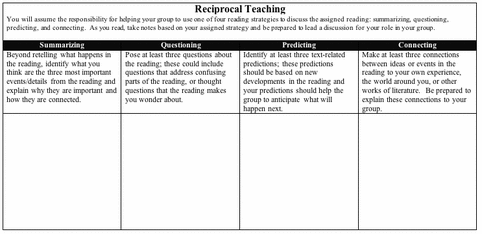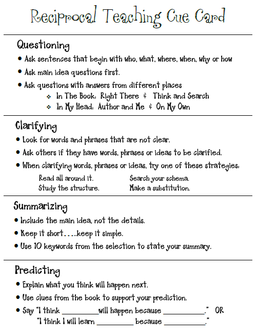What is Reciprocal Teaching?
Reciprocal teaching is a comprehension strategy where the students take on the role of being a teacher for their small group. Students are divided into small groups, usually consisting of four students. According to Jennings, Caldwell & Lerner (2014), the four parts of reciprocal teaching include: summarize, question, clarify, and predict. Each student is given a role and they complete the role for a text or for whatever the teacher determines. According to Reading Rockets (n.d), there are three main reasons why teachers should use reciprocal teaching and they include:
Reciprocal teaching is a comprehension strategy where the students take on the role of being a teacher for their small group. Students are divided into small groups, usually consisting of four students. According to Jennings, Caldwell & Lerner (2014), the four parts of reciprocal teaching include: summarize, question, clarify, and predict. Each student is given a role and they complete the role for a text or for whatever the teacher determines. According to Reading Rockets (n.d), there are three main reasons why teachers should use reciprocal teaching and they include:
- "It encourages students to think about their own thought process during reading.
- It helps students learn to be actively involved and monitor their comprehension as they read.
- It teaches students to ask questions during reading and helps make the text more comprehensible".
Visual Representations
Content Area Examples
Math- Reciprocal teaching can be easily adapted for a math lesson. Part of being a 21st century learner is successfully completing real-word math problems, such as problems dealing with money. As students are working through a real-world problem, they can do this successfully in reciprocal teachings groups. Roles for math reciprocal teaching might include a reader, identifier, planner and checker. The reader would read the problem to the group and underline important details. The identifier would also underline important details and would make sure every one if the group understands what the question is asking. The planner would determine how to solve the problem. The checker would check the group's work after the problem is solved.
Social Studies- Reciprocal teaching can also be adapted for a social studies lesson. The only thing that changes is the content of the text. If needed a fifth person can be added to the group and their role could be a researcher. This student would take on the role of researching a particular social studies topic.
Science- For a science lesson, students could use reciprocal teaching for an experiment. Before an experiment a student could predict what they think will happen, another student can write down questions they want to answer after the experiment, another student could summarize what happens after the experiment, and a fourth student could clarify any confusing conclusions.
Reading- Reading is the most common content area that reciprocal teaching is used for. As mentioned above, students can be the roles of a questioner, summarizer, clarifier, or predictor. If needed, students could also be in groups of five and the fifth student could take on the role of a connector. The connector would be in charge of connecting information to other texts, for example.
Math- Reciprocal teaching can be easily adapted for a math lesson. Part of being a 21st century learner is successfully completing real-word math problems, such as problems dealing with money. As students are working through a real-world problem, they can do this successfully in reciprocal teachings groups. Roles for math reciprocal teaching might include a reader, identifier, planner and checker. The reader would read the problem to the group and underline important details. The identifier would also underline important details and would make sure every one if the group understands what the question is asking. The planner would determine how to solve the problem. The checker would check the group's work after the problem is solved.
Social Studies- Reciprocal teaching can also be adapted for a social studies lesson. The only thing that changes is the content of the text. If needed a fifth person can be added to the group and their role could be a researcher. This student would take on the role of researching a particular social studies topic.
Science- For a science lesson, students could use reciprocal teaching for an experiment. Before an experiment a student could predict what they think will happen, another student can write down questions they want to answer after the experiment, another student could summarize what happens after the experiment, and a fourth student could clarify any confusing conclusions.
Reading- Reading is the most common content area that reciprocal teaching is used for. As mentioned above, students can be the roles of a questioner, summarizer, clarifier, or predictor. If needed, students could also be in groups of five and the fifth student could take on the role of a connector. The connector would be in charge of connecting information to other texts, for example.



